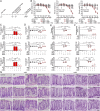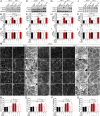Microbial tryptophan metabolites regulate gut barrier function via the aryl hydrocarbon receptor
- PMID: 32719140
- PMCID: PMC7431026
- DOI: 10.1073/pnas.2000047117
Microbial tryptophan metabolites regulate gut barrier function via the aryl hydrocarbon receptor
Abstract
Inflammatory bowel diseases (IBDs), including Crohn's disease and ulcerative colitis, are associated with dysbiosis of the gut microbiome. Emerging evidence suggests that small-molecule metabolites derived from bacterial breakdown of a variety of dietary nutrients confer a wide array of host benefits, including amelioration of inflammation in IBDs. Yet, in many cases, the molecular pathways targeted by these molecules remain unknown. Here, we describe roles for three metabolites-indole-3-ethanol, indole-3-pyruvate, and indole-3-aldehyde-which are derived from gut bacterial metabolism of the essential amino acid tryptophan, in regulating intestinal barrier function. We determined that these metabolites protect against increased gut permeability associated with a mouse model of colitis by maintaining the integrity of the apical junctional complex and its associated actin regulatory proteins, including myosin IIA and ezrin, and that these effects are dependent on the aryl hydrocarbon receptor. Our studies provide a deeper understanding of how gut microbial metabolites affect host defense mechanisms and identify candidate pathways for prophylactic and therapeutic treatments for IBDs.
Keywords: colitis; gut microbiome; inflammatory bowel disease; intestinal epithelium.
Conflict of interest statement
The authors declare no competing interest.
Figures







References
Publication types
MeSH terms
Substances
Grants and funding
LinkOut - more resources
Full Text Sources
Other Literature Sources
Molecular Biology Databases

